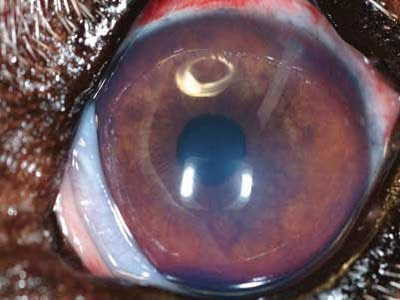GLAUCOMA IN THE DOG AND CAT CAT 
Glaucoma e'processo disease with multiple etiological which consists of an increased intraocular pressure with reduced sensitivity ' and function 'of the retinal ganglion cells.
It 's a painful condition that can' determine blindness' more 'frequently in dogs gatto.Il maintenance of intraocular pressure and' maintained by a balance between production and drainage of aqueous humor
Production is through the body the outflow in the ciliary and iris-corneal drainage combed through the ligament and uveal mesh astounded and here in the episcleral venous plexus. IRIS ANGLE
CORNEAL

are considered moderately elevated pressures between 25 and 30 mmHg higher than 30 mmHg.
After 24 hours creates a pressure of 40 Hg irreversible changes of the eye.
Cats can tolerate intraocular pressures with less damage to the optic nerve and retina than dogs, with a vision retained even at high pressures.
Classification according to etiology: primary and secondary
Primary
rare common in dogs and cats, not 'associated with other ocular diseases goniodisgenesi
Secondary:
arises from changes in the crystal (dislocation, intumescent cataract, uveitis facolitica , uveitis with fibrovascular membranes that pass through the drainage angle, use of drugs
classification based on the state of drainage angle: angle-closure angle
open angle open. glaucoma
the cause lies in the trabecular meshwork (Goniodisgenesi) intrasclerale plexus and collecting tubule

Closed corner (narrow):

and the iris' anterior displacement with reduction of the cornea to the anterior chamber causes may include: swelling of the iris to neoplastic processes, dislocation of the lens, vitreous protrusion in the anterior chamber, iris Dome ..
In most cases the cat and 'secondary to inflammation of the iris to block inflammatory cells iridocorneal angle. The primary form in the cat
e'rara you can ' osservare nei Siamesi, Persiani Europeo ,Birmani
Sintomi
Edema corneale,vasi congiuntiveli iperemici e distesi la forma acuta generalmente e’ monolaterale ,pupilla midriatica non reattiva alla luce.
Con il tempo la cornea presenta erosioni con tessuto di granulazione.
Lo stiramento del glogo causa dolore .L’animale a causa del mal di testa e’ iporeattivo .Il fondo presenta una papilla scavata (cupping) la retina diventa atrofica iperriflettente .In questo stadio l’occhio e’ cieco.
Fondamentale nel glaucoma arrivare alla diagnosi quando il quadro non e’ ancora irreversibile.
Spesso l’edema corneale viene confuso con una cheratite ,l’uveite associata puo’ to miosis, and therefore fundamental 'measurement of intraocular pressure in cases of uveal inflammation there is a rule or hypotonus.
In the cat and 'even more' hard to notice the beginnings of glaucoma since the sensational events occur when the glaucoma and 'already' in advanced stage.
Glaucoma affects the cat rarely and almost exclusively in the chronic form. Medical treatment of acute glaucoma
:
Intravenous osmotic diuretics (mannitol), topical agents drops to inhibit carbonic anhydrase (dorzolamide) three times a day, to improve the drainage with prostaglandin (latanoprost) acting in synergy with inhibitors, but are 'ineffective in cats
Treating any concomitant uveitis with systemic steroids and agents with local or systemic NSAIDs
The topical beta blockers are more' effective in cats than in dogs, are especially effective in controlling glaucoma and subclinical 'particularly suited to an extent Prior to the spokes in place, reduce the production of aqueous humor by only 5%, are less effective in cases of Goniodsgenesi The systemic carbonic anhydrase inhibitors are poorly tolerated in cats, dogs instead are used as first aid and then by with local ones to avoid side effects such as anorexia, diarrhea, vomiting, electrolyte imbalance
agents miotic as Pilocarpine 2% improves the flow, are contraindicated in cases of uveitis the same applies to prostaglandin analogues, either, so you do not seek in the case of glaucoma associated with an inflammatory process. Primary Glaucoma Surgical Treatment
When glaucoma can not 'be controlled with medical therapy is used for surgical treatment that involves the following steps:
Ciclodistruzione: with around 30 mmHg intraocular pressure is the controlled destruction of the epithelium of the body ciliary (decreasing production of aqueous humor) and opening portions of iris-corneal angle.
is practiced with a probe or cryostat with laser photocoagulation.
Drainage system (Gonioimpianto):
.jpg)

The best results are obtained with the combination of the ciclodistruzione gonioimpianto
consists of a tube fitted with a valve inserted under the conjunctiva that drains the fluid from anterior chamber to subconjunctival space where it is then absorbed by the vessels of the conjunctiva.

This plant can ', however, become blocked and make the intervention effective if you do not do to leave the valve obstruction with particular substances injected into the system. Where
of glaucoma with very severe pain and is used cecita'spesso enucleation.
Primary Prevention of Glaucoma:
is made with the control by gonioscopy, fundus and control must be practiced in all races in the contralateral eye rischio.Inoltre not concerned must always be treated with eye drops inhibitors beta-blockers and / or prophylactic

 FIG 2
FIG 2 

























.jpg)



